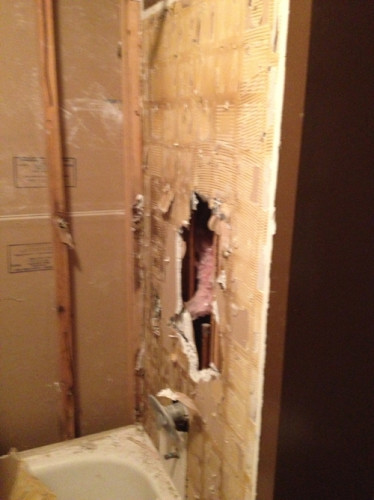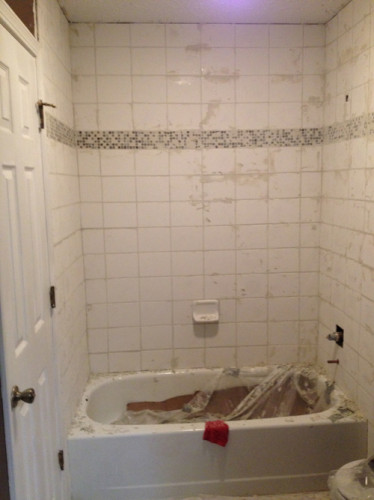How Easy is It to Retile Shower
Retiling a Shower
Posted by:

There was some water damage behind the tile in our shower. Although my husband, David, and I didn't know the extent of it, it was easy to tell by the loose tiles that something wasn't right. We knew we needed to assess the damage and retile the shower before things got worse.
The first step was ripping out the old tile and drywall. (When you're working in a high-moisture area like a shower, you are supposed to use concreteboard, which stands up better to water, or something similar, instead of drywall, but when our condo was built in the early 1980s, the builders used drywall.) We covered the tub with several layers of plastic to protect it, and started chipping away at the tile.
The pieces that had water damage came off the wall pretty easily. The drywall under it came off, too—it actually crumbled off in places. It took a little more work for the areas that weren't as damaged, but with the help of our reciprocating saw, we were able to get the shower down to the studs in just a few hours' worth of work.



We were happy to see that the studs weren't wet and there was no mold in the shower or behind the tub. The next step was putting the shower back together.
First, we replaced insulation behind one wall that separates our condo from the one next to us. It was easy enough to tear out the old (and in some places, wet) insulation and put new in, using a staple gun. Next, we put up thick plastic, or a vapor barrier, to keep any moisture away from the studs and insulation.
After that, it was time to attach the sheets of concreteboard. This took a little more work. Our brother-in-law came to help us with this part, and he and David worked together to measure the tub and cut sheets of concreteboard to fit. The tricky part was the wall where the faucet and showerhead were, as they had to cut a few holes to fit around these areas.
Once the concreteboard was in, it was time to patch the seams. We taped them and then "mudded" them with a thin layer of thinset.

After that was the fun part—tiling. We'd recently done another tiling project (read more here about tiling our kitchen floor), so we felt pretty confident in this step. We'd chosen to tile all the way to the ceiling with white porcelain tile, adding in a mosaic piece near the top for a little bit of decoration.


It was a long process that was rather slow-moving at times, but we got a pretty good system going. While I tiled the bigger sections of the wall (by applying thinset and then putting the tiles on the wall, using spacers to set them 1/8 inch apart), he measured the corners and other areas that needed partial tiles, and we worked together to tile those parts. The corners were definitely the most challenging.


After several days of tiling, and a few more hours of drying, it was time to grout. We decided to use white grout to match the white tile (and to better hide any imperfections in spacing). We applied the grout with a float, each of us taking half of the area and working from top to bottom. Even though the mosaic had some brown and beige colors, we decided to use the white grout there, too.

After grouting, we wiped the tile down with sponges, making sure to get grout off the tiles but not out of the spaces between the tiles. We continued to wipe it down once or twice a day for several days after grouting, just to remove the last of the haze on the tile.
Once the grout had dried, David put in the showerhead, handle and spigot, and we caulked around the tub and at the corners. After a couple more days of drying, we put our shower curtain back up and were (finally!) able to use our shower again!
The process is pretty straightforward, but it can definitely take some time. We worked at night and on the weekends, so it took several weeks to complete the project. We still need to seal the glass-and-stone mosaic and touch up the paint on the wall around the shower, but otherwise, the project is complete. It's nice to be able to use a new shower—one that looks better than ever, and one that isn't allowing the potential for water damage in our home.

Source: http://www.planitdiy.com/inspiration/in-kitchen-bath/retiling-a-shower/
0 Response to "How Easy is It to Retile Shower"
Enviar um comentário